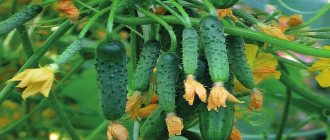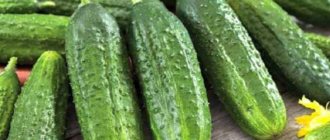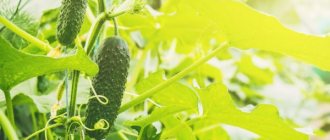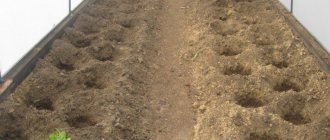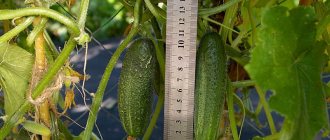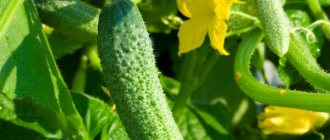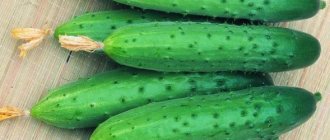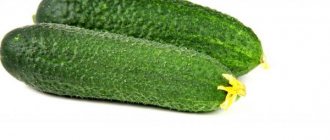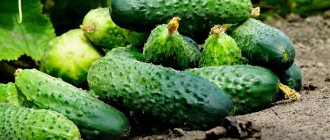Cucumber Salinas F1 is an early-ripening gherkin-type hybrid. The originator of the species is the Swiss seed plant. The hybrid was registered in the State Register in 2007. This species is suitable for cultivation in all regions of the country, intended for open ground and greenhouses.
Cucumber Salinas F1 is characterized by bunch ripening of fruits
Description of the cucumber variety Salinas F1
The hybrid is a medium-sized plant of an indeterminate species. Under favorable conditions, the length of its shoots reaches 1.8 m. Salinas F1 actively forms lateral shoots and leaves. Therefore, when growing, it is necessary to promptly remove excess shoots, leaving only 4-5 pieces. first row. The branches of Salinas F1 have a rigid structure, are not brittle, and are light green in color. The surface is slightly pubescent, the villi are sparsely located and spiny.
The leaf blades of this cucumber are medium-sized, dark green in color, and have short thick petioles. They are located opposite on the shoots. There are large teeth along the edges of the leaves. The surface of the plates, like the shoots, is pubescent, hard and corrugated.
The inflorescences of Salinas F1 are simple, bright yellow and grow in bunches. The root system of this species is fibrous, superficial, and grows widely.
Cucumber Salinas F1 is a parthenocarpic hybrid, so it does not need pollinators to set fruit.
The plant produces purely female flowers
Description of fruits
Salinas F1 produces fruits of 3-5 pieces. simultaneously. The cucumbers of this hybrid are of a regular cylindrical shape, 8 cm long and 3.0-3.2 cm in diameter. The average weight of the fruit is 70-80 g.
Important! The Salinas F1 cucumber is resistant to overripening; when biological ripeness is reached, growth stops, but the gherkins do not turn yellow.
This hybrid has all the same fruits. Salinas F1 cucumbers grow in bunches of 3-4 pieces. in the node. Their surface is glossy, finely tuberculate with thick white pubescence. The shade of cucumbers is dark green with small light spots and white longitudinal stripes, which make up 1/3 of the entire length.
The peel of Salinas F1 cucumbers is thin, dense, and does not suffer from slight mechanical stress, so the crop can be transported and stored for 2 weeks without loss of commercial quality.
The pulp is dense, juicy, without voids. The taste of Salinas F1 cucumbers is excellent, classic, without bitterness, even in the absence of regular watering. The fruits can be eaten fresh, and can also be used for pickling, canning and preparing salads.
During processing, cucumbers remain crunchy, dense, and there are no voids in place of the seed chambers.
Important! Overripe Salinas F1 cucumbers retain excellent taste.
Characteristics
Cucumber Salinas F1 exhibits relative resistance to low temperatures. Vegetation and fruit set are suspended if it is +14 degrees outside. The first cucumbers can be harvested after 38-40 days. The yield per plant is 9-10 kg, and from 1 sq. m. - about 17 kg.
Important! A lack of sunlight, as well as untimely watering, do not affect the formation of the Salinas F1 ovary.
To increase productivity, it is necessary to timely fertilize and loosen the soil at the base of the plants, which will improve the flow of air to the roots.
The hybrid easily tolerates heat and at the same time shows stable yields
Advantages and disadvantages
Despite the fact that the Salinas F1 cucumber has a number of advantages, which allows it to compete well with other types of crops, it has several disadvantages that should be taken into account. This information will allow every gardener to get a complete picture of this hybrid.
The main advantages of Salinas F1:
- early ripening;
- drought-resistant;
- self-pollinating;
- has good natural immunity;
- characterized by excellent taste;
- withstands transportation and long-term storage up to 2 weeks;
- consistently high yield, regardless of growing conditions;
- cucumbers are resistant to aging;
- universal fruits;
- one-dimensionality of gherkins.
The disadvantages of Salinas F1 include the inability to collect seeds for sowing, which increases costs. As well as average yields for the hybrid form of the crop.
Pros and cons of the variety
The Gosha cucumber variety has a large number of advantages. A description of the advantages of the Gosha variety is presented below.
pros
- Wonderful taste characteristics inherent in gherkin-type cucumbers.
- High productivity.
- Ability to grow in the shade.
- Versatility of use (Gosha is suitable for canning and fresh consumption).
- Ultra early ripening.
- Resistance to diseases and damage from dangerous insects.
- Good transportable properties and long shelf life.
- Gosha cucumber flowers do not require pollination.
Minuses
The cucumber variety Gosha f1 has no deficiencies. Cucumbers are easy to grow, the variety is quite unpretentious, and the taste is excellent.
Planting and care
Cucumber Salinas F1 can be grown in seedlings or planted directly in the ground. But in order to achieve maximum efficiency, it is necessary to comply with the timing of planting and further care, since the future harvest depends on this.
Sowing time
Planting Salinas F1 seeds should be done when the ground warms up to a temperature of +17-18 degrees, and the threat of return frosts disappears. Therefore, it is necessary to sow this cucumber in a greenhouse in the first half of May, and in open ground at the end of this month, if climatic conditions permit. When growing seedlings, the timing should be moved back by 2-3 weeks.
Selecting a location and preparing beds
For planting, you should choose a well-lit bed on the southeast side of the site. Light shading of crops throughout the day is allowed.
2 weeks before planting, you should dig up the soil and add organic matter at the rate of 5 kg per 1 sq. m. m. The hybrid prefers a neutral level of acidity, so if necessary, you need to add 200 g of wood ash to the soil for the same area size.
Cucumber Salinas F1 does not react well to drafts
How to plant correctly
Sowing Salinas F1 seeds should be carried out in holes to a depth of 1.5-2 cm. In this case, it is necessary to maintain a distance between plants of 40-50 cm, that is, per 1 sq. m. you can place 2-3 seedlings. Place 2 seeds in each hole, sprinkle them with soil on top and moisten the bed well.
When grown in open ground, crops must be covered with agrofibre, which will protect them from adverse weather conditions and speed up germination. If grown in a greenhouse, planting should be done in a similar way, and a support should be installed near each hole.
Important! A day before planting, Salinas F1 seeds should be wrapped in a damp cloth and placed in the vegetable section of the refrigerator, which will increase resistance to adverse weather conditions and activate growth processes.
To grow cucumber Salinas F1 in seedlings, you need to prepare peat cups, since this crop does not tolerate transplants well. They should be filled with a mixture of peat and sand, taken in equal volumes. Then moisten the soil and make a hole in the center. Plant 2 seeds in each glass. For germination, move the containers to a bright place with a temperature of +22 degrees.
Important! It is impossible to overexpose cucumber seedlings, as this leads to a decrease in yield.
A week before transplanting, seedlings must be hardened off. To do this, the first time they need to be placed outside in partial shade for 1-1.5 hours. And with each subsequent day, the time period should be increased by another hour. The day before transplanting, spray the seedlings with Zircon solution to minimize stress.
Choose a bed for cucumbers in a sunny place and not in lowlands, so that water does not stagnate there.
Salinas F1 cucumbers should be planted in the ground together with a peat cup so as not to disturb the root system. After this, to adapt, cover the plants with agrofibre for 2-3 days.
Aftercare
Salinas F1 requires regular watering, so in the absence of seasonal rains, this must be done daily. In this case, it is necessary to use settled water at a temperature of +18 degrees.
Important! Plants need to be watered at the roots so that moisture does not fall on the leaves.
After each moistening, the soil at the base should be loosened to a depth of 3 cm so as not to damage the roots. It is also necessary to carry out fertilizing. For the first time, Salinas F1 cucumber seedlings should be fertilized with organic matter at the initial stage of the growing season. And during flowering and fruit set, use phosphorus-potassium fertilizers.
Salinas F1 needs shaping. It should be grown in 4-5 shoots, which should be left from the stepsons of the first row. Then all the lateral shoots must be removed in a timely manner, as well as the leaves that are located in the internodes without an ovary must be cut off. There is no need to pinch the top of the Salinas F1 cucumber, since its shoots do not grow larger than 1.8 m.
Pros and cons of the variety
The Supercrunch variety, despite its demanding fertilizing requirements, is quite easy to cultivate and has many positive qualities. However, the cucumber needs painstaking care, especially for young shoots and during the flowering period.
pros
Supercrunch f1 has many important advantages for gardeners. The most important among them:
- extended fruiting - according to the description, a cucumber bush can bear fruit for several weeks;
- high yield - due to the bunch type of variety;
- excellent resistance of Supercrunch f1 to adverse weather conditions;
- high resistance to diseases such as tobacco mosaic, root rot, olive spot, etc.;
- unique taste qualities - cucumbers retain their density and taste even when canned, unlike many other early varieties, such as Sultan, etc.;
Supercrunch, judging by the description, is perfect for sale - they can easily withstand even long-term transportation without losing their presentation.
Minuses
The variety has few negative aspects, but they must be taken into account in order to get a good harvest. The most significant disadvantages of cucumber:
- dependence on fertilizers – Supercrunch f1 needs mineral and organic fertilizing to produce the yield indicated in the description;
- high watering requirements - cucumbers need frequent watering, they need a large amount of moisture;
- vulnerability to downy mildew - seed material and plantings should be treated with antibacterial drugs:
Like most hybrids, the variety is not capable of producing secondary seed material - cucumber seeds are purchased anew each time.
Pests and diseases
The hybrid exhibits increased resistance to pests and diseases. Therefore, it does not require protection when grown in a greenhouse. In open ground under rainy, cool summer conditions, the Salinas F1 cucumber may suffer from anthracnose. Therefore, for prevention, before flowering, plants should be sprayed with copper sulfate, and in case of prolonged precipitation, with colloidal sulfur.
When the temperature drops sharply, seedlings need to be covered
Features of agricultural technology of the variety
The hybrid plant has strong immunity to infectious diseases and parasites. The variety will not get sick in a greenhouse; in open ground, during the cold, rainy summer season, it may be affected by anthracnose. Reducing humidity during rains is problematic; bushes are treated with colloidal sulfur. For prevention, the cucumber crop is sprayed with copper sulfate before flowering. Parasites do not touch Salinas F1.
The hybrid Salinas F1 is grown by seedlings and direct planting of seeds in the soil. Seedlings grown at home are used regardless of climatic conditions. Direct planting is recommended for the south of the country. The main thing to remember for cultivation in a greenhouse is to create favorable conditions:
- temperature regime suitable for growing season – 23 °C;
- daylight hours – 8 hours;
- There is no need for additional lighting.
Supports and high air humidity are required. For cultivation in the garden, select a lighted area from the south or east. The hybrid is not afraid of shade at certain times of the day. Cucumber culture does not respond well to drafts. The composition of the soil should be neutral, enriched with nutrients, without stagnant moisture.
Cucumbers can be grown by direct sowing in the ground or through seedlings. Initially, the seeds are disinfected with manganese and wrapped in cotton moistened with water. Until the seeds have sprouted, the material is moistened daily, but not directly watered with water. After the grains germinate, they are sent to the beds. The sowing depth is 3-4 cm. If frosts are predicted, then the soil is covered with warm material or PE.
To obtain seedling material, seeds are sown in boxes with a light substrate, which is fed with organic matter. It will germinate in about a week and a half. They need to be watered with warm water once every 5 days. The seedlings are fertilized with complex minerals.
Note!
When the seedling material is 21 days old and each sprout has 4-7 leaves, the plants are sent to a permanent place.
The soil is loosened, disinfected with manganese or another agent, and fertilizers (organic matter or minerals, compounds diluted in water) are added to the soil. The hybrid variety is planted according to the 0.5x0.3 m pattern. The rational number of bushes per m2 of garden should not be more than 4 pieces. If a greenhouse structure is used for growing a hybrid crop, then it is recommended to plant no more than 6 bushes on the specified area.
Before planting, the seeds are placed in the refrigerator in a damp cloth for 24 hours. Plants are sown in the garden between May 15-30, depending on how hot the soil is; the optimal value is 18 °C. Landing:
- Dig up the area in advance and apply organic fertilizers.
- Make holes 15 mm deep.
- Plant 2 seeds, the hybrid has good germination, this amount is quite enough.
- Sprinkle with soil and fully moisten the crops.
- When it germinates, leave one strong plant in the hole.
- The interval between holes is 450-500 mm, 2-3 bushes per 1 m2.
The sequence and scheme for planting the Salinas hybrid cucumber crop in a greenhouse and an open garden are the same. A bed for cucumber crops is selected in the sun, with protection from wind and drafts, not in ravines, so that there is no stagnation of water there. A neutral substrate with an acidity of 6-7 pH is needed. If acidity is high, reduce it:
- Dolomite flour.
- Ash.
- Slaked lime.
- Chalk. After pumpkin and melons, you should not plant cucumber crops.
It is ideal to plant Salinas after:
- Tomatoes.
- Potatoes.
- Pepper.
- Cabbages.
- Physalis.
- Beans.
- Onions and turnips.
In the fall, the garden must be dug up and fed with organic preparations.
The timing of sowing seeds on seedling material is determined by climatic subtleties; after a month they can be planted in beds. Open approximately on the 15th of April. Landing algorithm:
- Take peat containers and fill them with a nutrient mixture of peat sand and compost in equal parts. Can be planted in peat cubes.
- Make 15 mm indentations, deepen one seed at a time.
- Place in a room with a constant temperature of 22 o
It is important to remember that a hybrid plant does not take root well after replanting; the hybrid is placed on the site in peat containers.
Watering and fertilizing
The hybrid plant is fastidious in watering; cucumbers are moistened every evening under the rhizome with a small amount of water. In a greenhouse, watering is carried out by drip in the same mode.
Note!
Feeding is carried out in the spring before flowering, using nitrogenous compounds. During the formation of greens
fertilize with superphosphate
.
After 21 days, potassium is added. Fertilize 3-5 times per season, it all depends on the depletion of the soil. Most of all, plant crops need feeding during the following periods:
- 2 weeks after the seedlings take root in a permanent place.
- At the beginning of color.
- When the first cucumbers form.
Fertilize again so that the interval between fertilizing is about 14 days. The first time it is necessary to feed with nitrogenous compounds (urea or organic matter, in the form of slurry, chicken droppings). Then, during flowering, phosphorus, for example, superphosphate, is added. During the fruiting period, it is necessary to feed with potassium and nitrogen compounds. In addition, organics give a good effect:
- Fermented nettle tincture. Collect mowed nettles or weeds to about a third of the volume in a barrel, add water and leave to ferment for 7 days, then dilute this composition in a ratio of 1:7.
- Yeast solution.
- Whey solution. 1 liter of whey is diluted in 10 liters of water and a couple of drops of iodine are added, after which the treatment is carried out.
- The soil must be loosened so that the rhizome receives oxygen.
The stems in the greenhouse are tied to supports. We must not forget about the formation of the bush. The Salinas cucumber hybrid bush is formed with 4 shoots from the bottom. As it grows, it is tied to a support. They cut off the shoots from the side; a lot of them grow. Remove foliage that does not have an ovary in its internodes. After harvesting the cucumbers, the foliage from below is also removed. The top is not broken; usually, it does not stretch above the support.
The hybrid plant is not afraid of almost any diseases. To prevent basic diseases, you need to properly care for the vegetable - avoid excess moisture, observe crop rotation, weed the weeds.
Note!
When it rains, the plant may become ill with anthracnose. For prevention, it is necessary to treat with colloidal sulfur.
Insects are rare. They are destroyed using store-bought insecticides.
